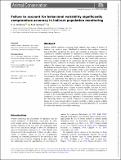Files in this item
Failure to account for behavioral variability significantly compromises accuracy in indirect population monitoring
Item metadata
| dc.contributor.author | Wessling, E.G. | |
| dc.contributor.author | Surbeck, M. | |
| dc.date.accessioned | 2023-01-23T13:30:07Z | |
| dc.date.available | 2023-01-23T13:30:07Z | |
| dc.date.issued | 2023-08-01 | |
| dc.identifier | 283068800 | |
| dc.identifier | dc7a4194-9726-4f76-84cb-b442cbdb49fb | |
| dc.identifier | 85144236288 | |
| dc.identifier | 000898010300001 | |
| dc.identifier.citation | Wessling , E G & Surbeck , M 2023 , ' Failure to account for behavioral variability significantly compromises accuracy in indirect population monitoring ' , Animal Conservation , vol. 26 , no. 4 , pp. 558-572 . https://doi.org/10.1111/acv.12844 | en |
| dc.identifier.issn | 1367-9430 | |
| dc.identifier.other | RIS: urn:7C36A9C7E0A24FC731CC3B66385DFADB | |
| dc.identifier.uri | https://hdl.handle.net/10023/26811 | |
| dc.description | Funding: This work was supported by Harvard University. | en |
| dc.description.abstract | Indirect wildlife population surveying largely depends upon counts of artifacts of behavior (e.g., nests or dung). Likelihood to encounter these artifacts is derived from both artifact production and decay, and variability in production behavior is considered to contribute minimally to inaccuracy in wildlife estimation. Here, we demonstrate how ignoring behavioral variability leads to significant population misestimation, using an example of an endangered ape, the bonobo (Pan paniscus). Until now, a single estimate of nest construction rate has been used to extrapolate bonobo densities, assumed to be broadly representative of bonobo sign production behavior. We estimated nest construction rates across seasons and social groups at the Kokolopori Bonobo Reserve, Democratic Republic of the Congo, and find nest construction rates in bonobos to be highly variable across populations as well as seasonal within populations. Failure to account for this variability led to degradation in the accuracy of bonobo population density estimates, accounting for a likely overestimation of bonobo numbers by 34%, and at worst as high as 80%. With this example, we demonstrate that failure to account for inter- and intrapopulation behavioral variation compromises the ability to estimate both relative and absolute wildlife abundances. We argue that variation in sign production is but one of the several potential ways that behavioral variability can affect conservation monitoring, should be measured across contexts whenever possible, and must be considered in population estimation confidence intervals. With increasing attention to behavioral variability as a potential tool for conservation, conservationists must also account for the impact that behavioral variability can have upon wildlife population estimation. Our results underline the importance of observational research to wildlife monitoring schemes as a critical component of conservation management. We discuss the avenues through which behavioral variability is likely to impact wildlife monitoring accuracy and precision and propose potential approaches for accounting for behavioral variability in wildlife monitoring. | |
| dc.format.extent | 15 | |
| dc.format.extent | 745373 | |
| dc.language.iso | eng | |
| dc.relation.ispartof | Animal Conservation | en |
| dc.subject | Accuracy | en |
| dc.subject | Behavioral variation | en |
| dc.subject | Bonobo | en |
| dc.subject | Group level | en |
| dc.subject | Population estimates | en |
| dc.subject | Population monitoring | en |
| dc.subject | Seasonality | en |
| dc.subject | Wildlife surveys | en |
| dc.subject | NDAS | en |
| dc.subject | MCC | en |
| dc.title | Failure to account for behavioral variability significantly compromises accuracy in indirect population monitoring | en |
| dc.type | Journal article | en |
| dc.contributor.institution | University of St Andrews. School of Psychology and Neuroscience | en |
| dc.identifier.doi | https://doi.org/10.1111/acv.12844 | |
| dc.description.status | Peer reviewed | en |
This item appears in the following Collection(s)
Items in the St Andrews Research Repository are protected by copyright, with all rights reserved, unless otherwise indicated.

